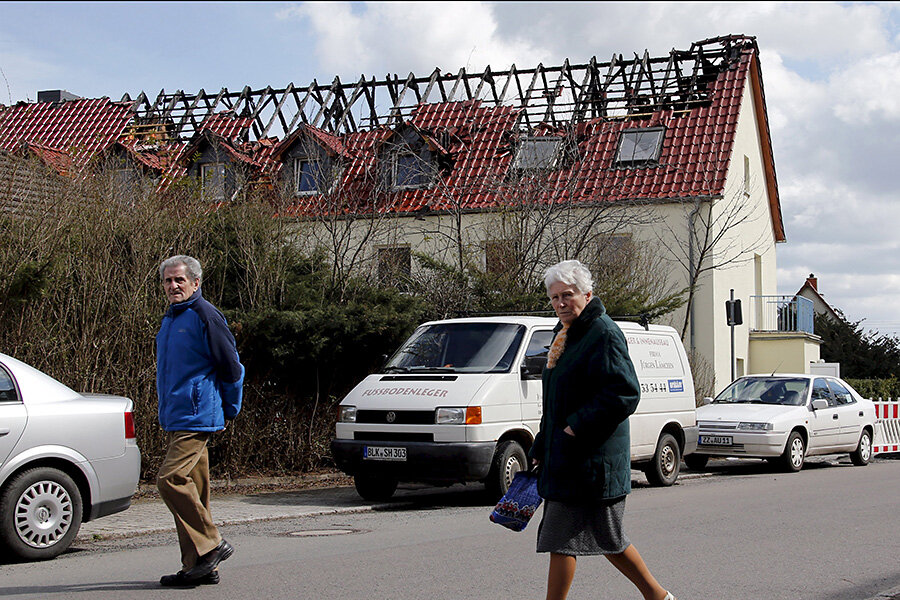Seeking Refuge: Can Germany afford to let xenophobes chase out immigrants?
Loading...
| Berlin
Last year, Germany became the No. 1 destination in the world for refugees. And by the end of 2015, the government in Berlin estimates more than 400,000 people could seek refuge here – twice the number that arrived last year. Most of them are escaping poverty in the Balkans, ongoing wars in Syria or Iraq, or the despotic regime in Eritrea.
The influx has stirred anti-immigrant sentiment – and violence – among those Germans troubled by the prospect of having to compete with refugees for state resources. Host towns across the country, from poorer eastern states to the more prosperous south, are seeing a flare-up of attacks against asylum seekers, their families, and the shelters that house them.
But ironically, the flood of refugees comes just as Germany could most use them – to rejuvenate a graying workforce that is set to shrink by 6 million over the next 15 years and by 20 million in the next 35, according to the German Federal Statistics Office. But balancing the need to offset population decline and respecting local concerns about culture, that could empower far-right elements if ignored, won't be easy.
Increasing attacks...
Since the beginning of the year, anti-refugee attacks have become an almost daily occurrence. The immigrant lobby organization Pro Asyl has counted nearly 150 physical attacks or acts of vandalism or property damage against refugees or their dwellings. By comparison, official statistics put the total number of such attacks in all of 2014 at 162. In 2013, there were 58; in 2012, only 24.
Just last weekend, arsonists set a planned refugee shelter in the southwestern town of Remchingen ablaze, a handful of neo-Nazis attacked a group of asylum seekers at a village fair near the Baltic coast, and guns were reportedly fired at the windows of a shelter outside Leipzig. A Red Cross worker was also pelted with rocks while she worked in an emergency tent for refugees.
The frequency with which the attacks are happening has shown that while some of them may be extraordinary – like one in an otherwise sleepy eastern Germany town in April following the resignation of the town’s mayor, who cited threats by local neo-Nazis over his pro-refugee stance – the violence is no longer exceptional.
“There’s more than one reason for this,” says Maximilian Pichl, a legal assistant at Pro Asyl. “It’s a melange of structural problems, including insufficient funding for accommodations, which leads to overfilled shelters that then become a target for violent attacks.”
Mr. Pichl also cited a surge in support for anti-immigrant movements here, such as the grassroots organization Pegida or the political party Alternative for Germany. Both have been accused of fostering a climate that makes xenophobes feel validated, and thus indirectly encourages them to do harm.
A recent study by the Friedrich-Ebert-Stiftung, a German foundation that promotes democracy worldwide, found that 44 percent of Germans harbored animosity toward refugees.
Of course, the numbers of attacks upon immigrants pale in relation to overall figures on assault or property damage. In 2014, according to data from the Federal Criminal Police Office, there were more than 125,000 cases of "dangerous and serious bodily harm" and 600,000 incidents of property damage. But the low proportion belies the actual visibility of crimes against refugees in society.
...amid increasing need
At the same time that some Germans are striking out at immigrants, Germany is nearing a point where immigrants may be a solution to the country's "gray bomb" – the post-war generation now reaching its senior years without the number of younger workers needed to support it.
Indeed, immigrants like Thierry Danchop from Cameroon, who arrived a year ago but is still awaiting clearance to work in Germany, are impatient to fill that gap.
“I want to work but there's no way," he says, lamenting his inability to seek gainful employment while his status is still in limbo. "Refugees bring a lot of potential but people don't want to see it because we don't have papers."
That sentiment – wanting to work – has resonated with politicians and industry leaders here who say Germany cannot afford to overlook the legions of incoming refugees as a potential source of labor.
“Generally speaking, labor market-oriented immigration and immigration on humanitarian grounds must be clearly distinguished. But there is overlap,” says Achim Dercks, the deputy managing director of Germany's Chambers of Commerce. "Refugees may have potential skills that are in demand in German companies."
"It is therefore especially important for Germany to make itself as attractive and cosmopolitan as possible,” he adds, noting that only 12 percent of businesses were turning to migrants to replace employees entering retirement three years ago. Today that number has risen to 21 percent.
There is a feeling that the potential advantages of the rise in refugee numbers has not always been well communicated to the smaller, tight-knit communities that are ultimately the ones responsible for hosting the new arrivals.
Many communities have gone above and beyond what is required of them, mobilizing volunteers to help the refugees get around or teach them German. To be sure, surveys have shown that half of Germans want their government to take in even more refugees. Yet there are many who still feel forgotten by the shot callers in Berlin.
Another person who feels forgotten is Mr. Danchop. The debate about the costs of housing, feeding and educating asylum seekers leaves him feeling incredulous. His monthly 325-euro ($350) stipend has to cover his lawyer fees, a transportation pass to get him to his daily language classes, his cell phone bill, and food. Exhausting his budget before the end of the month has sometimes meant going hungry.
"I didn't come here to eat and sleep," he says.





